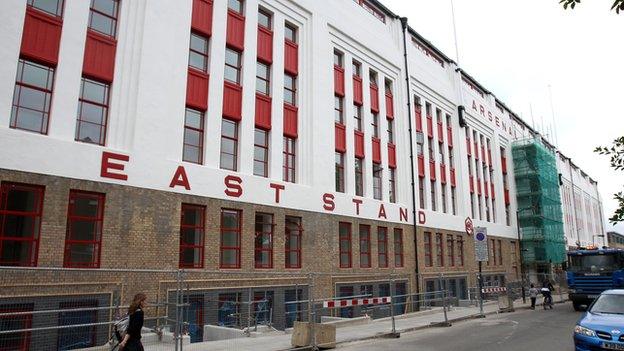Southampton FC: Twenty years since the last game at The Dell
- Published
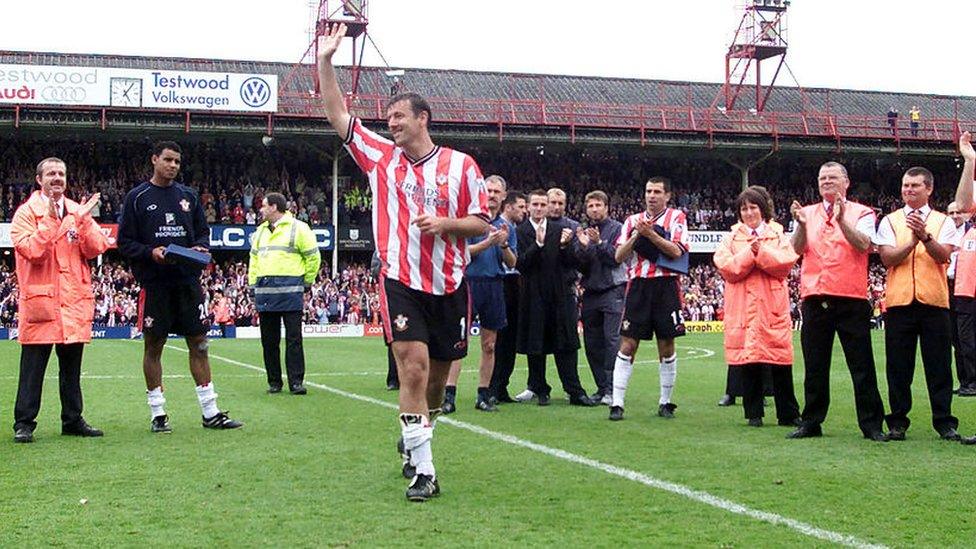
The perfect farewell, Le Tissier waves goodbye to The Dell
The script of Southampton Football Club's final league game at The Dell 20 years ago couldn't have been written any better.
Level at 2-2 against Arsenal, a long ball falls to none other than Saints legend Matt Le Tissier, who swivels on the spot and volleys in a last-minute winner.
A fairytale finish.
"Who better to say farewell than one of the finest players to wear the red and white?" said Jon Champion, the BBC's Match of the Day commentator on 19 May 2001.
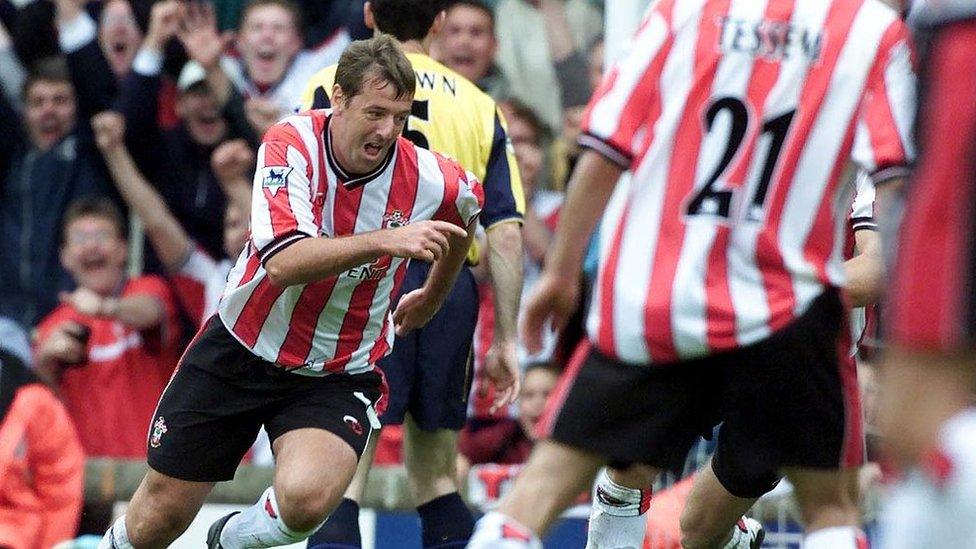
Le Tissier wheels away after scoring the last-minute winner against Arsenal in the final league game
It was the perfect goodbye to the iconic football ground, which was the scene for countless memories for generations of Southampton fans over 103 years.
Today marks the 20th anniversary of the farewell exhibition game against Brighton at The Dell, which took place a week after the competitive season ended.
Two decades on, Le Tissier told the BBC his final goal at The Dell was the stand out memory in his 16-year Saints career.
"That will always be a very special moment in my life, not just my career," he said.
"That was just dream stuff the way that it ended there."
But what was it about The Dell which made it so special to those who graced its hallowed turf, or supported from the stands?
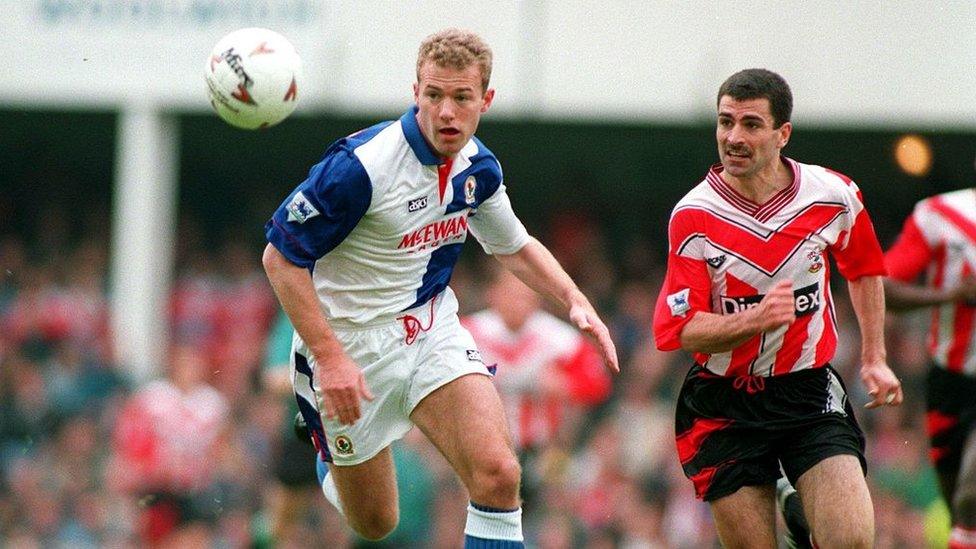
Francis Benali chases down former Saints striker Alan Shearer during a Premier League match at The Dell in April 1994
Le Tissier said he loved The Dell because of its design, which he said suited his style of play.
"The fans were just right on top of you," he said. "It was just so tight.
"I wasn't somebody who needed wide open spaces to go chasing into. I needed it to be tight and compact, so I could use my skill in tight areas."
The Southampton legend said former opponents often recalled how they "hated" playing away at The Dell because of its set-up aiding a raucous reception from home supporters.
For former left-back Francis Benali, peering through the gates as a schoolboy to get a glimpse of the pitch on his way to school, forged his dream of playing for his hometown club.
"To achieve a dream you have always had as a young boy to be out on the surface, playing in the stadium, was incredible," he said.
"It was a unique stadium. You knew every nook and cranny of it."
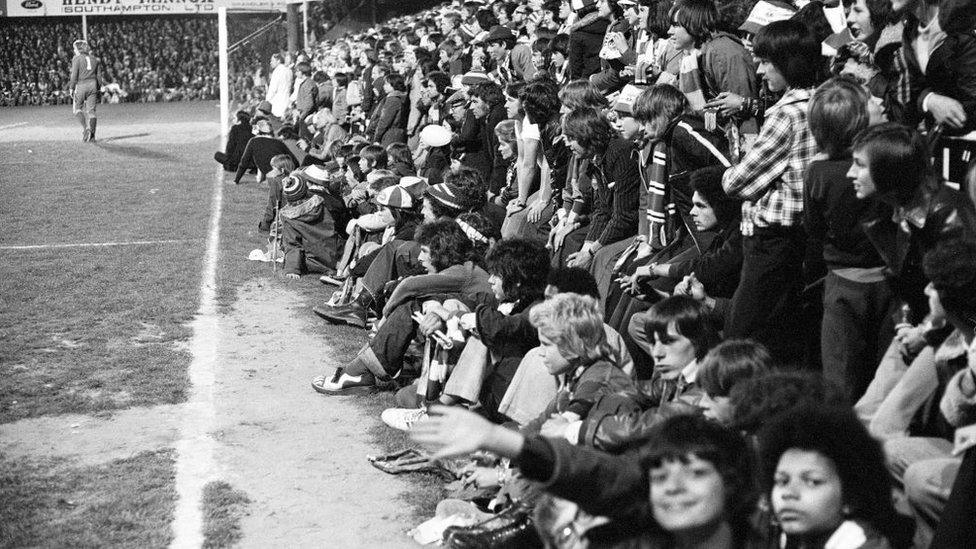
Fans were almost on the pitch at a testimonial for Saints legend Mick Channon on 3 May 1976
Benali said the "closeness" of supporters to the pitch acted like a "12th player" for those Saints sides that defied the odds to stay in the Premier League in the so-called "great escapes" of the 1990s.
"If we were on our game and had the supporters behind us, it made for a difficult afternoon for the opposition," he said, adding: "It would get us fired up as well."
The Dell was the stage for Southampton Football Club for 103 years, from its formative years in the Southern League to the riches of the Premier League.
The club moved to the purpose-built stadium on 3 September 1898, after playing a couple of seasons at Hampshire County Cricket Ground in nearby Northlands Road and the Antelope Ground in the St Mary's area before that.
The new ground's name originated because of the land it was built on - 'dell' meaning a small valley surrounded by trees - and according to club historian and fan David Juson, the name stuck as a result of "the lack of any lead from the club".
Mr Juson, who co-authored Full-time at The Dell, said the brains behind the ground were that of fishmonger and club director George Thomas, who secured the land and "basically took over the project".
"Everything about it was plush, it was a first-class ground in every respect," he told the BBC.

A newspaper cutting reports on a fire to the East Stand of The Dell in the 1920s
The first decade at The Dell was a golden one for Saints, Juson said, with the club winning four Southern League titles, reaching the FA Cup final twice, the semi-finals four times between 1898 and 1908. One cup run included a 4-1 home victory over Football League champions, Liverpool.
In the summer of 1927, Archibald Leitch, an architect of many of Britain's football grounds, extended The Dell's East Stand and work started on a new West Stand, before a discarded cigarette was thought to have started a blaze that burned the East Stand down after the last game of the 1928-29 season.
During the early years of World War Two, the club was forced to play all matches at away grounds, including at the home of arch rivals Portsmouth - Fratton Park.
It came after a bomb landed in the Milton Road penalty area during The Blitz, leaving an 18-foot crater which damaged an underground culvert and flooded the pitch., external The Saints moved back to The Dell in 1941.
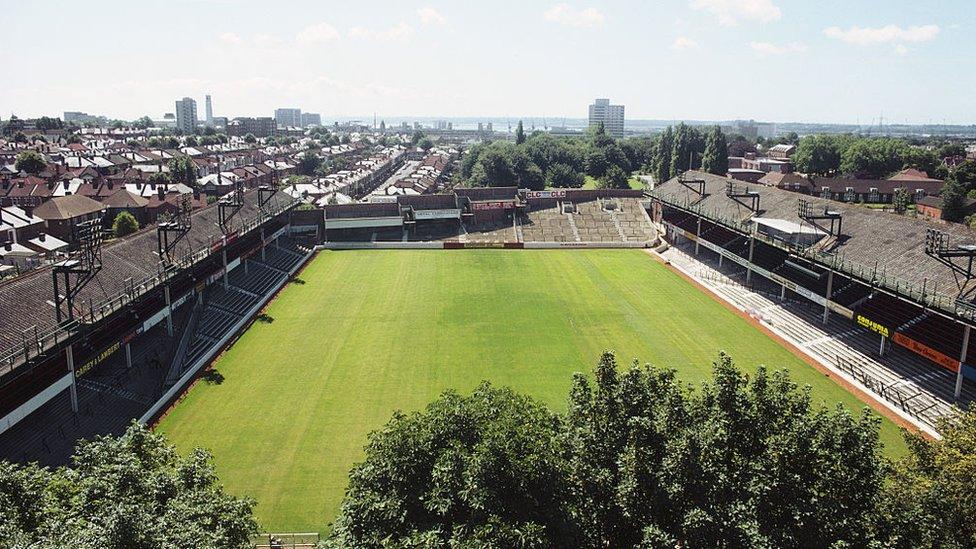
The chocolate box stands, pictured here in 1980, at the Milton Road end of The Dell were installed in the post-war years
In the post-war years, The Dell underwent renovations which included the erection of the three unique "chocolate boxes" atop the stand at the Milton Road end of the ground.
In 1950, The Dell became the first ground in England to have permanent floodlighting installed as the club progressed through the levels of English football until The Dell staged its first Division 1 match in 1966.
Three years later, on 8 October 1969, The Dell recorded its largest league attendance of 31,044, as a Saints side featuring a young Mick Channon were beaten 3-0 by a Manchester United team boasting George Best and Sir Bobby Charlton.
Mr Juson said it was "not unusual" for players to collide with fans who were crammed into the front of the terraces.
"You were practically playing on the wing," he joked. "It was very tight. You could hear them [the players] swearing at each other."
More renovations followed during the 1980s and 1990s, with the terraces replaced by seats and new stands at the Milton and Archers Road ends, following the Taylor Report.
The footprint stayed the same, with the ground crammed in tighter than ever to the residential streets around it - a block of flats called Overdell View, behind the Archers Road end, gave residents a superb view of matches from their balconies.
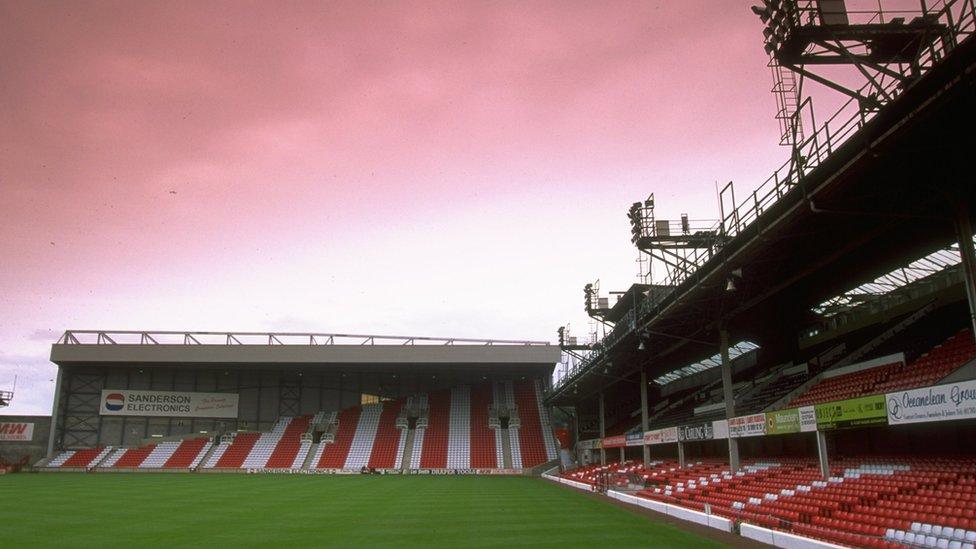
The final wedge-like Milton Road stand was built in 1994
It led to a new uniquely-shaped Milton Road End - a literal wedge between the pitch and the road - but the new stands didn't change The Dell's infamous DNA of being a tight, compact and imposing ground.
"There was something about the atmosphere," Benali said, adding: "There was almost something you could sense and smell in the air."
But despite evolving with the times, a capacity newly-capped at 15,200 wasn't sustainable for a Premier League club entering the 21st Century and after many debates, arguments and failed plans, the move to St Mary's - a new 32,600-seater stadium on former gas works land in the heart of the city - was finalised.
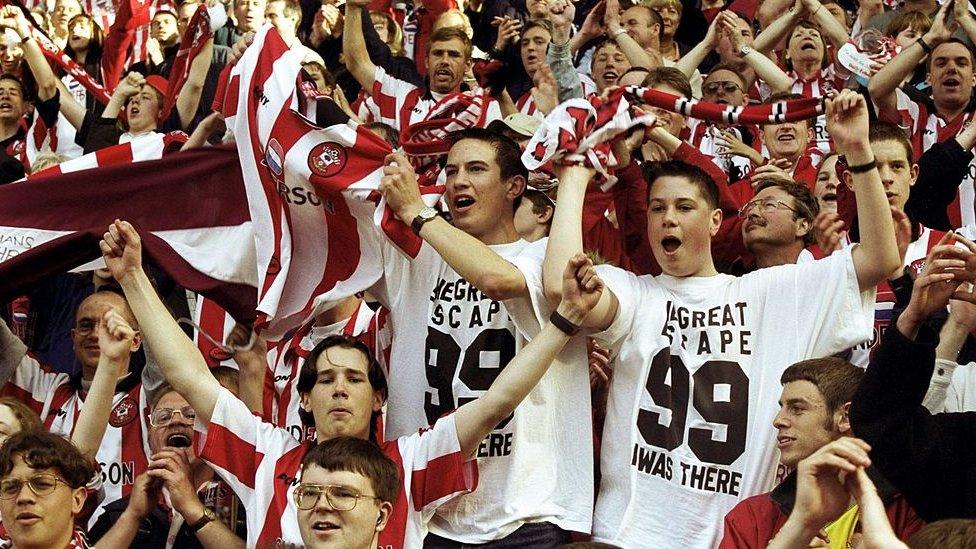
The Dell was the scene for many of Southampton's escapes from relegation
Although the Saints signed off in style against Arsenal in the last competitive game at The Dell, a special friendly against then Division Three champions Brighton - a repeat of The Dell's first game - marked the final chapter in the stadium's history.
Wearing commemorative red-and-white quartered shirts, Uwe Rosler scored the final and only goal on 26 May 2001 before the game was finished three minutes early as fans invaded the pitch to say one last goodbye.

Fans invaded the pitch and grabbed souvenirs after the Brighton match
Nick Illingsworth, a lifelong Southampton fan, said after the final whistle went "all you could hear was the sound of hammers and scraping" as supporters salvaged a souvenir of their beloved ground.
Many unbolted their seat, while others cut out a piece of the turf or made off with hoardings from around the pitch.
Mr Illingsworth later bought a turnstile at auction, while Luke Glasspell took the home bench, which now sits in his shed.
"It's not the bench, it's the memories which are the most important," Mr Glasspell said.
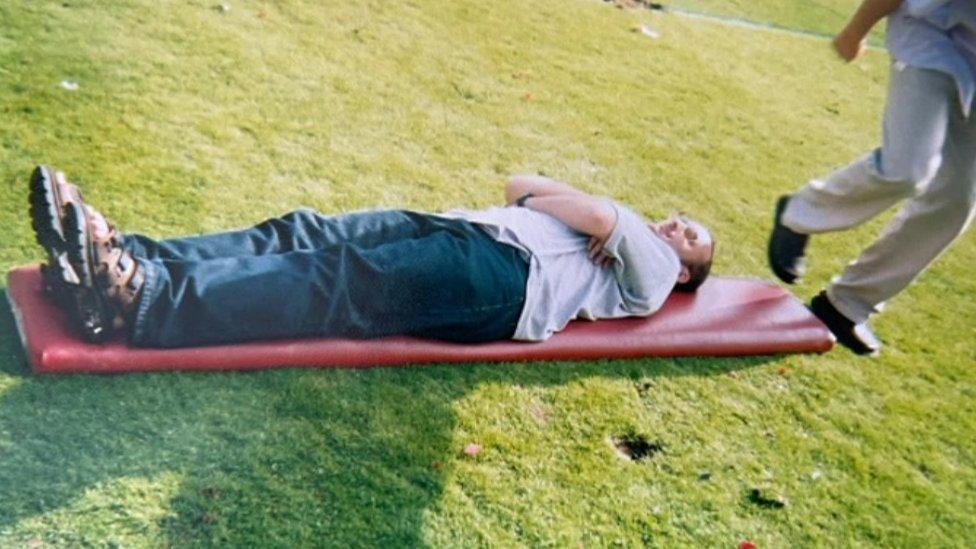
Luke Glasspell unscrewed the The Dell's subs' bench to take home
Richard Anderson, who has built a Subbuteo version of The Dell in his garden, went to the Brighton game prepared with a little ratchet spanner to take his seat off.
"I was an apprentice mechanic at the time, so that worked quite well," he added.
And so bulldozers moved in and the sun set on The Dell as the Saints moved a mile across the city to St Mary's.
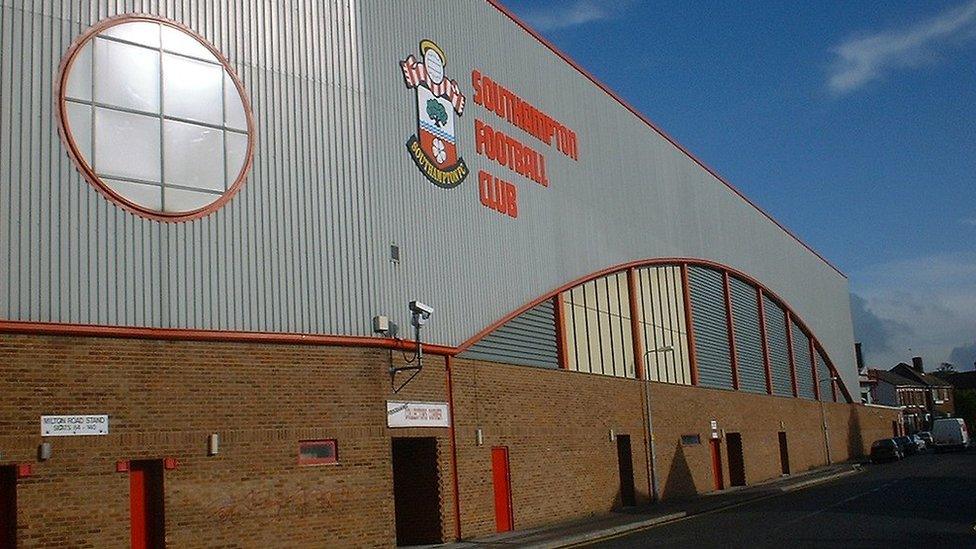
The Milton Road End was uniquely shaped due to its proximity to the road
Life after The Dell would see the club flirt with Europe before slipping into the lower leagues for the first time in 27 years and enter financial troubles before bouncing back and becoming an established Premier League outfit again in recent years.
Today, The Dell is a mixture of houses and flats with apartment blocks named after former players, such as Le Tissier Court, which feature pictures of the old ground and former Saints players in the lobbies.
The development follows the shape of the ground, with buildings being erected around a central open space and a small park area which is decorated with the imprint of football boots, as subtle reminders of what one stood on the site.
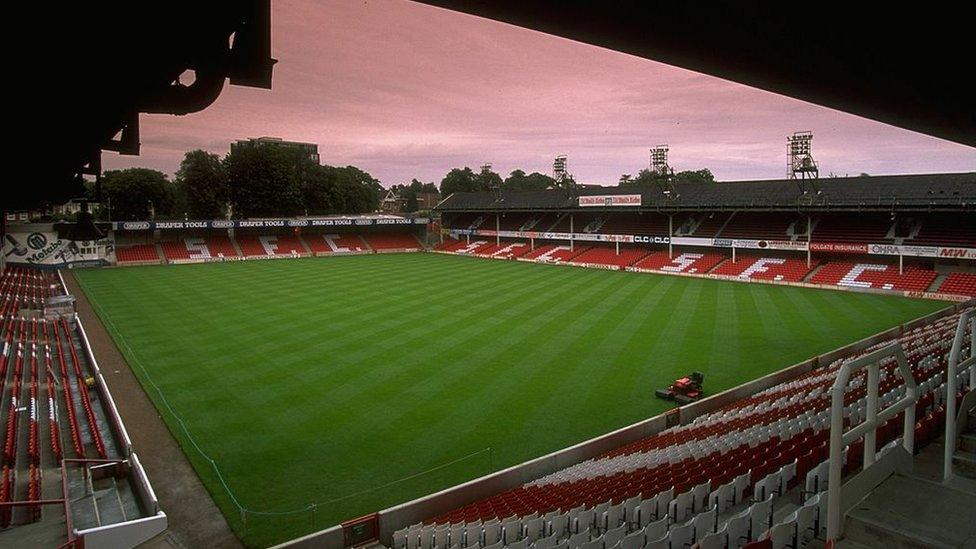
Southampton Football Club left The Dell in 2001
But for the fans that cheered from the stands and players who graced the pitch, happy memories remain.
"I wouldn't change it either now. It was a unique stadium - wonderful place to play football," said Benali.
"And if I was playing on the modern pitches as well, not just the modern stadiums, I wouldn't have had a dodgy bobble to have blamed my bad passing on."

Follow BBC South on Facebook, external, Twitter, external, or Instagram, external. Send your story ideas to south.newsonline@bbc.co.uk, external.
Related topics
- Published21 October 2014
